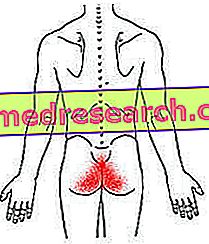Generality
Coccygodynia is a painful syndrome affecting the pelvis, particularly the coccyx or the surrounding area. The causes of coccyginia can be different, therefore the therapeutic approach is also variable.

The coccyx
The coccyx represents the terminal tract of the spine, located just above the crack in the buttocks. Its structure is composed of the set of 3-5 vertebral units which, with the exception of the first segment, are typically fused together. The terminal apex is slightly curved forward, so that the vertex of the bone is oriented towards the front of the body. The dorsal surface of the coccyx serves as an attachment site for the large gluteus, the pubococcygeus muscle and the anococcygeal ligament, while the sphincter of the anus is inserted towards the apex.
Causes
Parto
Coccygodynia most frequently affects female sex, often due to traumatic events associated with childbirth. During pregnancy, towards the end of the third trimester, the coccyx becomes more flexible to help the woman to give birth more easily. In some cases, birth can cause excessive tension of muscles and ligaments connected to the coccyx, with partial dislocation of the same.
Coccyx trauma
A strong impact at the base of the spine, like a fall with landing on the buttocks (contact sports, skiing, ice skating, horse riding etc.) can damage the coccyx. In most cases, only a bruise will arise. However, if the trauma is violent it can cause a fracture or a dislocation (ie a displacement from its natural seat) of the coccyx. If this happens, the bones that compose it can become hypermobile, triggering a pathological instability that manifests itself with chronic inflammation and pain.
Repetitive strain injuries
Coccygodynia can arise as a result of sports activities involving repeated movements of the sacro-coccygeal region, such as cycling or rowing. Persistent friction and pressure on the coccyx region can induce trauma to ligaments and surrounding muscles, resulting in tissue inflammation and pain.
Bad posture
If an improper sitting position is maintained at work or while driving, it is possible that too much pressure is exerted on the coccyx. This can cause pain, which tends to worsen if the person maintains this posture for a long period of time.
Overweight
Obese patients may experience posterior subluxation of the coccyx, as they are more susceptible to intrapelvic pressure during a prolonged sitting position or accidental fall.
Age-related wear
With aging the small cartilage discs that help keep the coccyx in place can wear out, causing pain.
Other causes
A less common etiology of coccyginia is associated with the onset of a tumor (osteosarcoma, sacro-coccygeal teratoma etc.) or with the expansion of metastatic cancer. Other less common causes of local pain include spinal imbalances, pilonidal cysts, bone spurs, compression of nerve roots and infections. In some cases, coccygodynia may occur in the absence of obvious pathological changes involving the coccyx ( idiopathic form ).
Symptoms
To learn more: Symptoms Coccigodinia
The main symptom of the disorder is pain located at the base of the spine, where the coccyx is located.
The coccyx pain can be so intense that it is difficult to carry out normal daily activities, such as driving, bending or sitting; however, its intensity varies from person to person, and can get worse over time.
Other symptoms of coccyginia may include:- Persistent back pain ;
- Pains in legs, buttocks and hips;
- Pain before or during evacuation (coccygodynia often worsens with constipation and can be alleviated with defecation);
- Pain during sexual intercourse (rare);
- If the injury is traumatic, a bruise may be present;
- In women: increased pain during menstruation.
The coccyx pain can be particularly intense when the patient rises from the sitting position or when the region is directly compressed.
Diagnosis
Coccygodynia is not a serious disorder, but it is important to rule out the presence of other pathological conditions. In most cases, the doctor can diagnose coccygynia by evaluating the symptoms reported by the patient and performing a physical examination of the lower back and spine. A thorough check of this area, by palpation, allows to detect any abnormal masses or abscesses (infections). A radiographic survey will then confirm the diagnosis of coccyginia.
Comparison of radiographic images taken in both sitting and standing positions can help determine:
- Excessive or abnormal coccyx mobility;
- The fracture of one of the bones that make up the coccyx.
Coccygodynia can also be observed radiographically in subjects with normal coccygeal movement. In these cases, symptoms may arise secondarily to tumors, infections, coccyx bursitis or post-traumatic arthritis of the sacro-coccygeal joint.
To investigate the origin of any uncommon manifestations associated with coccydynia, such as fever or unexplained weight loss, the doctor may recommend more thorough examinations, such as an MRI or bone scan; in this way other conditions can be excluded, such as a neoplasm or a bone infection, responsible for pain in the pelvis.
Treatment
The treatment of coccyginia varies depending on the cause and on the extent of the pain.
drugs
The disease usually responds well to conventional therapy with non-steroidal anti-inflammatory drugs (NSAIDs) to relieve pain, associated with muscle relaxants to relieve excessive muscle contraction. Symptoms typically resolve within a few weeks.
In a minority of cases, the pain may persist for more than three months (chronic coccyginia) and will probably require a combination of treatments to regress. The various treatment options are described below.
Non-steroidal anti-inflammatory drugs (NSAIDs)
The first approach involves the administration of analgesics / anti-inflammatories, such as ibuprofen, naproxen or paracetamol. If the pain is mild or moderate, treatment with painkillers may be sufficient to alleviate the symptoms. NSAIDs can also help reduce inflammation around the coccyx. It may take a few weeks or months of treatment before you get a significant reduction in pain.
Other painkillers
In more severe or long-lasting cases (chronic coccygodynia), the doctor may prescribe a painkiller called tramadol for a short period. This drug can be addictive and cause several side effects, such as constipation, headaches and dizziness. If tramadol is prescribed for long periods of time, to avoid withdrawal symptoms, the dose should be gradually reduced before being suspended.
Corticosteroid injections
Corticosteroid injections alleviate the symptoms of coccyginia (inflammation and pain), with effects that can last up to several weeks. Sometimes, the drug is associated with a local anesthetic, to make the therapy even more effective. Corticosteroids cannot completely cure the condition and too many injections can damage the coccyx and lower back. For this reason, this type of treatment can be given approximately once or twice a year.
Read also: Coccigodynia Medications »
Complementary therapies
Some spinal manipulation techniques, used in physiotherapy, osteopathy and chiropractic, can provide temporary relief from pain. The use of specially designed pillows to relieve pressure on the coccyx can also be helpful.
Surgery
In a small number of cases, only when all other conservative treatments are unsuccessful can surgical removal of the coccyx (coccygectomy) be recommended. Surgery is generally reserved for patients with advanced coccygeal instability (eg, subluxation or hypermobility). During a coccygectomy, the surgeon performs a small incision to completely or partially remove the coccyx. Muscles, tendons and ligaments attached to the removed bone segment are reconnected to other parts of the pelvis to preserve their function.
After surgical treatment for coccyginia, approximately 80-90% of people show a marked improvement in symptoms. In about a third of cases, a post-operative infection occurs. It is believed that this common complication may occur due to the position of the coccyx (anorectal area). Coccygectomy may require quite long recovery times, even of several months.



